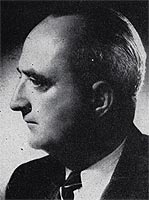
 Jean Royère was born on July 3, 1902, in Paris, to a Breton father and a Lorraine mother, both avid travelers with a strong artistic culture. He completed his studies at various colleges in Paris, but they were not particularly brilliant.
Jean Royère was born on July 3, 1902, in Paris, to a Breton father and a Lorraine mother, both avid travelers with a strong artistic culture. He completed his studies at various colleges in Paris, but they were not particularly brilliant.
He had no formal art education or technical knowledge. After spending five years in Le Havre involved in export business, he began dabbling in decoration as an amateur. At the age of 29, in 1931, he gave up a promising position to embark on his career as a decorator. He spent two years as an apprentice in a furniture factory to learn the trade, and in 1933, he completed one of the large brasseries on the Champs-Élysées.
In 1934, he joined Gouffé, who remained his publisher for eight years and exhibited his work at the Salon d'Automne in 1934 and at the Salon des Artistes Décorateurs in 1935. Since then, he has consistently participated in all major exhibitions in France and abroad. At the 1937 International Exhibition, he had 22 stands. He has received numerous awards and recognition everywhere he exhibited. Shortly after the war, he was the first French decorator to establish decoration houses abroad and promote the reputation of French design.
He opened a house in Cairo in 1946 and in Beirut in 1947. In these countries, he completed significant official and private installations, such as the French Consulate in Alexandria and the summer residence of the French Embassy in Lebanon, and he worked in most Middle Eastern countries, particularly for King Saud of Arabia and the former King Farouk. Jean Royère's activities span Paris, provinces, England, Belgium, the Netherlands, Switzerland, Sweden, South America, the USA, and Finland, where he decorated the French Legation.
Jean Royère's work is a reflection of his personality: that of a fanciful artist. Without any specialized training, he became a decorator because he found the adventure amusing. He sought this adventure without principles or rules, and he pursued it with a sort of passion. The mediocre student transformed into a dedicated worker, extending his scope of action to nearly as far as the airplane, which allowed him not to waste a minute, could take him.
However, he did not merely take his concepts beyond our borders; he also learned from new habits and techniques, often not well-known in France, assimilating them and enriching his ever-curious mind with these diverse experiences.
There is a distinct Jean Royère style characterized first by the use of a wide variety of materials. He employs them as needed, always in harmony with the personality and habits of the "client." Wood, bamboo, cork, lacquered metal, straw, and pressed flowers from herbariums – he even made furniture with bricks and covered ceilings and walls with sponge fabric! Despite his claim of not adhering to rules, his fanciful designs do follow preferences, if not actual laws.
Jean Royère rarely conceives isolated pieces of furniture; instead, he first arranges a highly rhythmic and decoratively sparse architectural setting where paintings are seldom planned, and he prefers fabrics with vibrant colors and elaborate patterns. Fireplaces always find a place in his rooms, cleverly resolved, and lightweight luminaires with multiple metal branches rise like curious flora.
The interiors created by Jean Royère are cheerful, youthful, and full of unexpected innovations.
